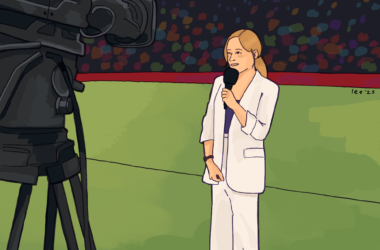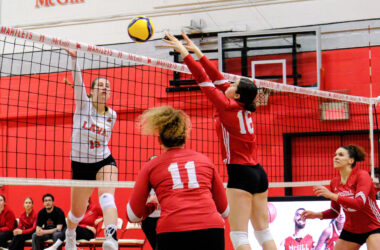This past Thursday, Hockey Night in Canada kicked off its 54th season on the CBC. This year’s edition features a few fresh faces in former San Jose Sharks colour commentator Drew Remenda and former Canadian women’s national team captain Cassie Campbell as well as a new feature called “Think Hockey.” We had a chance to catch up with former NHL goaltender and current HNIC “Behind the Mask” analyst Kelly Hrudey, about speculation of HNIC moving to CTV, the new NHL, the challenges of broadcasting and of course, his famous bandanas.
Do you think there should be an extra effort made to keep HNIC at the CBC because of the historical ties, or should it go to the network that makes the best offer?Well I suppose there are two thoughts on that. The first would be that you like the history and I know that’s something that a lot of Canadians have expressed to me, that it would seem odd if it weren’t on CBC. The second would be that it should go to whoever does the best job because it is such an important property. Having said that, I think that when I watch, whether it’s TSN, Sportsnet or The Score, I think they all do a great job and they all have terrific analysts, I think that we have a terrific show as well. I think we broadcast the game as it should be and we bring an important difference to the broadcast, which is that we make sure to remember how the show was done 50 years ago and try to stay true to that.
What do you think of the new NHL and how do you expect it will evolve this season?I hope that it continues to morph into how the game is supposed to be played and last year was a good first step. I know it’s not for everybody but I prefer the game as it was last year. It just seems to me that if they can continue along this path and make sure that they enforce all those penalties, we’ll get rid of all that stuff that bogged the game down for the last five years. But the coaches are smart and if you give them a break they’ll go back to it, so we have to make sure that the rules are enforced as they should be and that the product can continue to grow from that.
Did you always see yourself becoming an analyst when you retired?I had hoped so but honestly, I figured it was a bit of a long shot. When I first started playing in New York I really enjoyed the interviews that you do in a big city like that and you do tons of them, that’s really where I got the interest and my foot in the door. But it’s one thing to have an interest; it’s another to be hired. So I was really fortunate and I tell you what, I’ve learned from some of the best at Hockey Night. The presence that that show has and the people who work behind the scenes is just amazing.
Is there anything that as a player you think helped facilitate your transition into the booth?Clearly. When everything’s live there’s nowhere to hide. When you’re playing goal and you’ve got Mark Messier and Jari Kurri coming down on you two-on-one you’ve got to react quick and decisively and it’s no different when you’re in broadcasting. When the light is on it’s live, you’re in front of a million and a half Canadians and you’re just asked a really tough question, you cannot answer with a cliché. You have to give a real analytical answer about what just happened and why, while sounding like you know what you’re doing.
Not just as a former player, but as a Canadian, what does it mean to work for HNIC?Well it’s an institution. I think when I had my first opportunity in 1994, the pressure of that was almost overwhelming. More so than anything I’ve ever done I think because of the prestige that the show has. When you’re sitting behind the desk and you hear that HNIC music come on in your ear, just the thoughts that run through your mind: Can I live up to the people that have been at this desk prior to me? It’s not a lot different in that sense from when I first broke into the NHL with the New York Islanders and they had just won their fourth Stanley Cup. There I was trying to live up to those standards, it’s just like on Hockey Night. There have been a lot of great broadcasters that have been on before me and so I have to live up to that standard. What that does though is it makes you work harder; you do more research to make sure that you’re prepared so that you can carry on that tradition.
You found it more pressure filled then a Stanley Cup finals game in the Montreal Forum?I’d probably say yes because, as silly as it sounds, I had a lot of experience playing hockey prior to that. When you’re growing up and you’re playing road hockey or you’re in the rink, that’s all experience and those are all things that you can draw upon. But when you’re an NHL player and you’re thrown into a broadcast booth or behind a desk, I had no experience whatsoever, I didn’t even know any of the terminology. So you’re learning on your feet and hoping that you’re doing the right thing but you’re guessing in some cases too. So in that sense it was a lot more difficult than a lot of my playing experiences.
Finally we would be remised if we didn’t ask about the origins of your famous bandana?[laughs] How did I know? It’s pretty simple and I never intended it to be a trademark of mine but I guess it’s kind of turned into one. I always had long hair and I wore contact lenses when I played. I needed something to keep the sweat out of my eyes because as anyone who wears contacts knows, sweat and contact lenses don’t mix very well. I tried a whole bunch of different things and finally I decided to go to the t-shirt that you wear under your equipment. I tried that and it seemed to be pretty absorbent so I went with that and lo and behold over time it sort of became, I guess reluctantly to me, this trademark. After a while I even asked some friends if I should get rid of it and they said no, people recognize you for that. So I kept wearing it but I guarantee you the day I retired those all went in the garbage. There are no more of the originals floating around.







